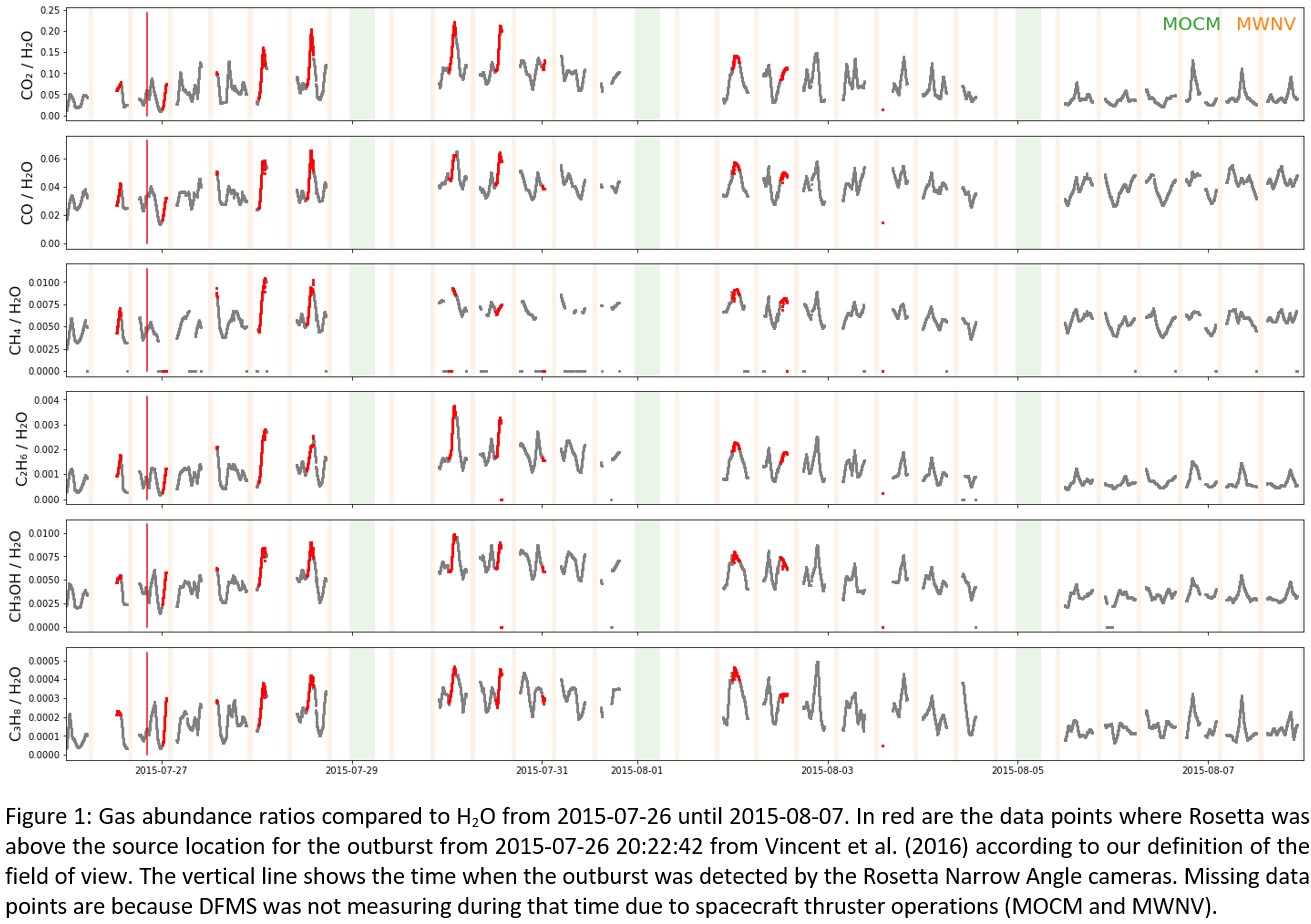Rosetta/ROSINA DFMS view of the summer fireworks on comet 67P
- 1University of Bern, Physics Institute, Space Research & Planetary Sciences, Bern, Switzerland (daniel.mueller@unibe.ch)
- 2Laboratoire Atmosphères, Milieux, Observations Spatiales (LATMOS), Saint-Maur, France
- 3Department of Climate and Space Sciences and Engineering, University of Michigan, Ann Arbor, MI, USA
- 4Royal Belgian Institute for Space Aeronomy, BIRA-IASB, Brussels, Belgium
- 5Space Science Directorate, Southwest Research Institute, San Antonio, TX, USA
- 6Department of Physics and Astronomy, The University of Texas at San Antonio, San Antonio, TX, USA
- 7University of Bern, Center for Space and Habitability, Bern, Switzerland
Vincent et al. (2016) studied a 3-month period surrounding comet 67P’s perihelion passage in August 2015. They detected and characterized 34 different dust outbursts with the Rosetta cameras. The sudden and brief release of dust of such transient events is characterized by a short lifetime. In their study, Vincent et al. (2016) estimated the source location of the observed outbursts. They were almost entirely on the Southern hemisphere and mostly located close to morphological boundaries of 67P. Thus, a link between morphology and the outbursts is assumed. In addition, these authors also approximated the local time since sunrise on the surface for each outburst event. Their result suggests that outbursts either appeared when the local surface is at its maximum daily temperature and subsurface volatiles produce an outburst, or when the Sun just began to shine onto the surface, thus inducing large temperature gradients and thermal cracking of the surface. In addition, Vincent et al. (2016) proposed that collapsing cliffs are the third mechanism triggering such events. However, the in-situ composition of the dust or gas released by the outbursts has not been studied yet, even though this might largely improve the knowledge about the underlying mechanisms generating such events.
In this work, knowing the source locations of the outbursts observed in Vincent et al. (2016), the gas composition in the coma after such events is studied by analysing ROSINA/DFMS mass spectrometry data and possible release mechanisms are discussed. A correlation in terms of angular separation of the sub-spacecraft latitude and longitude and the source location of the dust outburst is needed, as the gas speed is much faster than the observed dust outburst. Furthermore, Rosetta was mostly not directly above the source region during the actual camera observations. Only later or before, as the comet rotated, did Rosetta overfly the source location. Due to this time difference between the observation and the measurement of these dust events and thus the spread of the ejected gas, a distinct field of view needs to be defined in order decide whether the measured gas originated from the outburst source location or not. Consequently, it is possible that several outburst locations overlap with the same peaks in the gas ratios, making it difficult to differentiate a detection. In addition, as the outbursts were very short-lived appearances and thus mostly only detected in one image, the flow direction could not be determined making it impossible to partly decrease the field of view. Thus, a careful evaluation of each peak and its measurement configuration is necessary.
Figure 1 shows gas abundance ratios for CO2, CO, CH4, C2H6, CH3OH, and C3H8 compared to H2O for the outburst from 2015-07-26 20:22:42. For all depicted ratios, several peaks were measured at the time Rosetta flew over the outburst source location. This indicates that a larger amount of CO2, CO, and different organic species compared to H2O has been released by the outburst. It is possible that pockets of these species were buried just below the comet’s surface. Our findings show, that some features are already seen before the observed outburst itself, indicating a possible leakage of such gases creating such an event. Still, it is yet unknown whether these gases were responsible for the outbursts to appear or whether they were just released by the outburst as a by-product.

References:
Vincent, J.-B. et al., 2016, MNRAS, 462, S184–S194, https://doi.org/10.1093/mnras/stw2409
How to cite: Müller, D., Altwegg, K., Berthelier, J.-J., Combi, M., De Keyser, J., Fuselier, S., Pestoni, B., Rubin, M., and Wampfler, S.: Rosetta/ROSINA DFMS view of the summer fireworks on comet 67P, Europlanet Science Congress 2022, Granada, Spain, 18–23 Sep 2022, EPSC2022-517, https://doi.org/10.5194/epsc2022-517, 2022.

